Pubblicato il 12 Maggio 2025
Anima Mundi: The World Soul in Art and Archetype
di Gautam Jhanjee
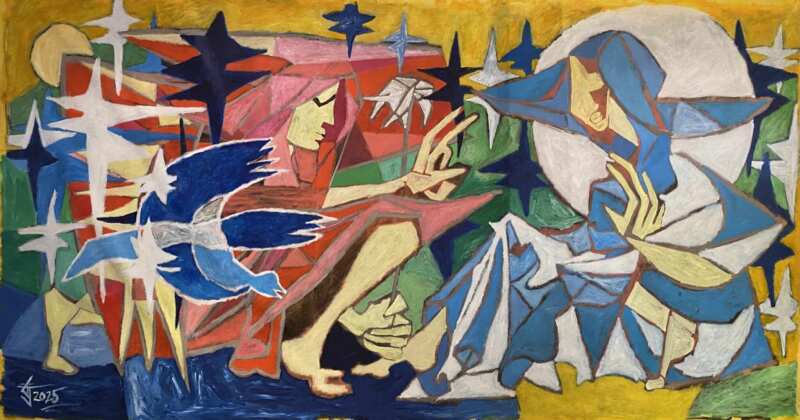
The Symbolic Feminine as Cross-Cultural Universal
The feminine archetype, in its multitude of cross-cultural forms, is one of the essential, recurrent universals in the story of humanity’s sacred and mythological history. This universality has been the central theme of Goddess with a Thousand Faces: The Feminine in Myth and Cosmos, a 2025 exhibition by Australian-Indian artist Gautam Jhanjee, in Canberra, Australia. The exhibition comprised 13 large-scale paintings on canvas, each centred on a particular archetype and interpreted through the artist’s symbolic voice. What follows is a brief reflection on six of the artworks and how their symbols echo some of the world’s oldest and most enduring myths, sacred traditions and cultures.
The Annunciation in a Field of Stars
The painting at the beginning of the article, The annunciation in a field of stars is a robed female figure in blue who encounters a male presence in a space defined by both layered depth and intimate interiority. Stars permeate the scene, amplifying a sense of cosmic vastness, whilst the painting’s central theme – the numinous bursting into the mundane – is grounded through Biblical iconography: Mary, the Archangel Gabriel, a white lily and a dove. Though Christian, the Annunciation as a symbol belongs to a broader anthropological lineage of sacred messengers who bring divine knowledge to the human world. Like the Greek Hermes, Thoth from ancient Egypt and Eshu, the Yoruba trickster, Gabriel acts as a bridge between the sacred and the mundane. The appearance of this archetype marks a rupture in normal time and the birth of a new order. Through this encounter and Gabriel’s revelation, the feminine stands at the sacred threshold through which new meaning enters the world.
Shakti and The High Priestess

The high Priestess, (1210w x 1780h mm, 2024) – Acrylic on Canvas]
These two paintings show seated female figures in cross-legged yogic postures – one with hands forming a mudra at the third eye, the other gesturing the shape of a sphere at her torso. Eyes closed or obscured by shadow, their gaze turns inward. These works touch on a sacred, universal motif: the body as axis mundi, a conduit or temple for channelling presence.
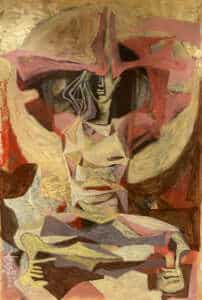
Shakti (1205w x 1780h mm, 2024) – Acrylic on Canvas
Scholars have cited two artefacts, separated by millennia and vast geographic and cultural distance, as being thematically linked through this ritual posture: the Pashupati Seal from the Indus Valley (c. 2350– 2000 BCE) and the Gundestrup Cauldron from Denmark (c. 1st century BCE). The former depicts what is believed to be a proto-Shiva; the latter, a horned god in the ‘master of animals’ motif. The same core gesture points toward a symbolic unity across the Eurasian landmass.
Stillness and the Ceaseless Wind

‘Stillness and the Ceaseless Wind’ – Acrylic on Canvas, 3190w x 1770h mm, 2025
A torrent of blue robes define a woman who bounds through space – yet her face and arms remain in a calm, meditative composure. She reflects the timeless mystic, unmoved by the passing of ages and epochs – the Self that is both motion and presence at once. She stands within a universal lineage of inwardly anchored mystics who simultaneously inhabit the world: Zen masters, devout abbesses, and wandering sadhus are all manifestations of this archetype. As such, the painting becomes a symbol of stability in the face of continual, transformative change.
The Eternal Return
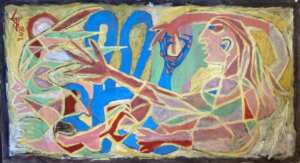
‘The Eternal Return’ – Acrylic on Canvas, 3160w x 1780h mm, 2025
A Mother Goddess communes with a magical blue serpent in a primeval garden, next to a hybrid avian-plant form to the left, all under the mandala symbol of a life-giving sun. Like the Neolithic Mother Goddess figures from Çatalhöyük or Malta, she is full-figured, evoking fecundity and the Earth’s abundance. Her companion, the Serpent, embodies more than just primal danger – it symbolises a shedding of the old, eternal continuity and healing. When paired together, Sacred Mother and serpent form a recurrent alignment of the feminine principle with the cycles of time, earthly wisdom and transformation.
Incantation
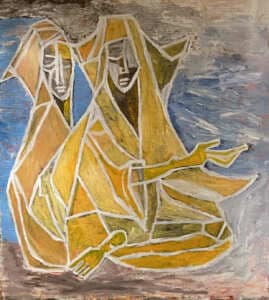
Incantation’ – Acrylic on Canvas, 1650w x 1775h mm.
An elemental, arid land of white-hot sky and stark terrain forms the backdrop to two seated women, clad in ochre with head coverings suggestive of a mystical, ancient order. One chants a sacred incantation whilst the other bears witness in silent contemplation. These figures embody the archetype of the desert anchorite, whose geography formed the foundation of their spiritual path: vast and pared down to essence. Their twinship gestures toward the core of the piece – duality in all its forms – a cross-cultural constant at the heart of every spiritual tradition. Inner and outer, above and below, ego and shadow: all pointing towards a moment of integration and unity.
Thresholds and Continuities
These artworks highlight the ongoing vitality of the feminine principle as a constant in the broader human imagination. Whether as recipient of divine revelation, witness, bodily world-axis, or inwardly oriented mystic, these archetypes remain ubiquitous. Origin, dissolution, and rebirth: feminine cyclicality is the pattern of life itself, through which form arises and eventually returns. In this light, Gautam Jhanjee’s paintings become contemporary expressions of this archetypal ground, revivifying ancient symbols for our current age.
Gautam Jhanjee
Image Credits
All photographs are from the exhibition Goddess with a Thousand Faces: The Feminine in Mythand Cosmos, March-April 2025, at Humble House Gallery, Canberra, Australia
About the Artist
Gautam Jhanjee is an Australian-Indian artist whose large-scale symbolic paintings engage
archetypal, mythic, and spiritual themes through cross-cultural sacred imagery. His work has been
featured in regional art centres, international spiritual art festivals, and exhibited through galleries
in Australia and India.
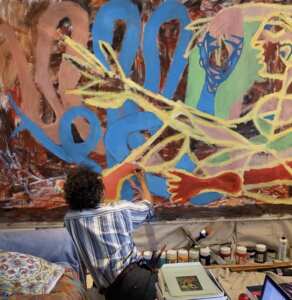
The artist painting in his studio
Gautam Jhanjee, Canberra, Australia May 2025

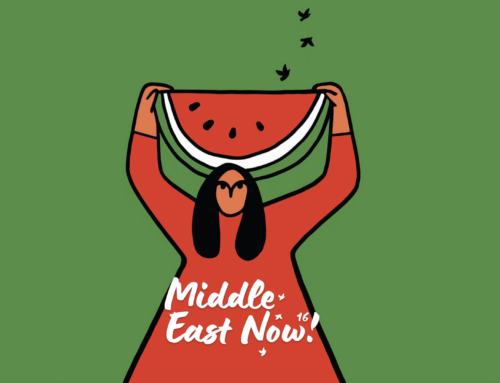

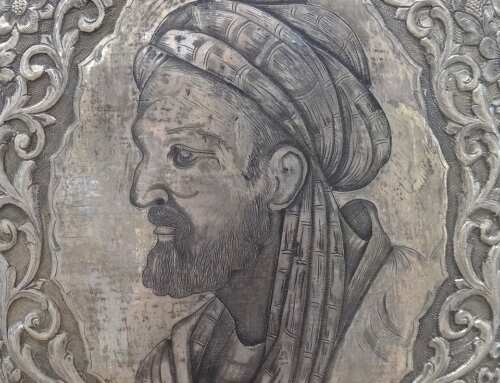






Rivista di Antropologia Culturale, Etnografia e Sociologia dal 2011 – Appunti critici & costruttivi